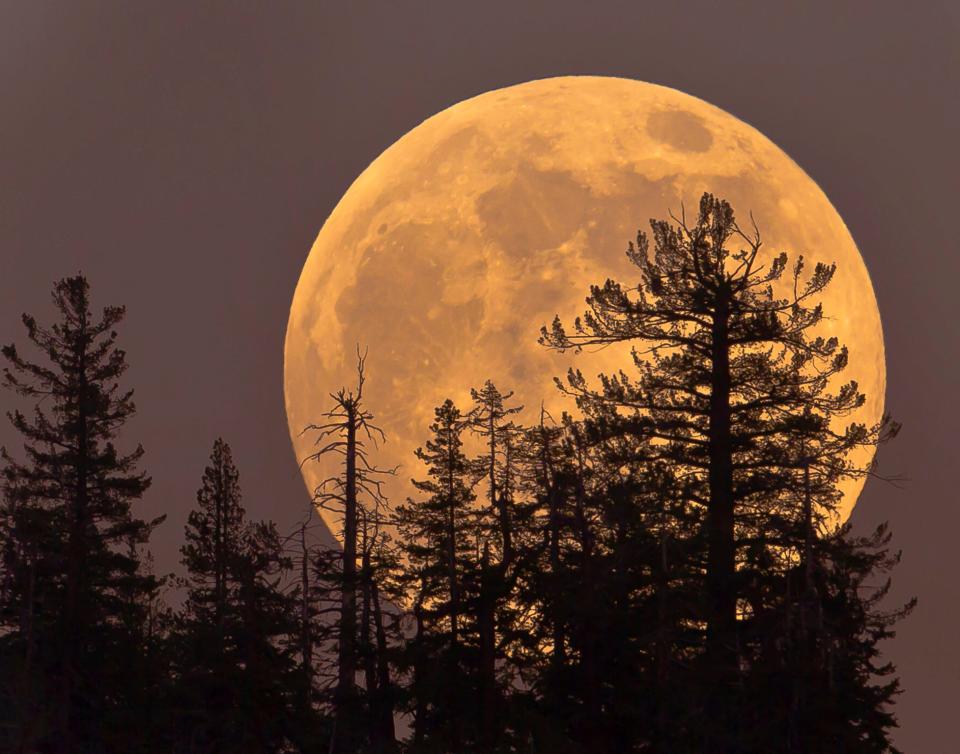High Desert moon lovers prepare for 2 super full moons in August
Photographers and moon lovers are preparing for the Full Sturgeon Moon, which will rise over the High Desert on Aug. 1, and a full Blue Moon coming later this month.
This week's celestial appearance of Earth’s sole natural satellite is considered a supermoon, one of two in August.
The month will close out when the full Blue Moon appears on Aug. 30, according to Space.com.
A full blue moon is considered the second full moon in a calendar month. August’s moons could also be referred to as super blue moons.
A full moon occurs when the Earth lies directly between the sun and moon, so the moon appears completely illuminated. This happens about once a month or 29.53 days on average, according to FullMoonology.

Moon rising
The sturgeon supermoon will appear at its peak illumination at 11:32 a.m. on Tuesday, Aug. 1, according to In the Sky.
The Aug. 30 super blue moon will rise at 4:10 p.m. PST — reaching its peak at 6:26 p.m. PST.
Theresa Armstrong of Victorville said she’s ready to photograph both supermoons, preferably in Big Bear or another location in the San Bernardino Mountains.
“Taking photos of full moons and supermoons rising over mountains or lakes are my favorite,” Armstrong told the Daily Press. “I took quite a few last month in preparation for the supermoons.”
Armstrong said she became fascinated with the moon as a child when her father would look at the moon and begin singing ‘Fly Me To The Moon’ by Frank Sinatra.
Once in a blue Moon
The phrase "once in a blue moon" means a fairly infrequent event and not quite regular enough to pinpoint.
It's not rare to see two full moons in a month; it happens about seven times every 19 years, according to Sky & Telescope.
The rarity of two monthly moons comes because the moon's phases are out of sync with the calendar, and all the months but February are longer than the lunar cycle of 29.5 days.
Months have different lengths, so the phenomenon moves around a bit.
The Centre for Astronomical Heritage lists the next Blue Moon occurrences on:
May 31, 2026
Dec. 31, 2028
Sept. 30, 2031
July 31, 2034
Jan. 31, 2037
Oct. 31, 2039
Supermoons
Supermoons occur because the moon's orbit around the Earth is not a perfect circle but a flattened circle or an ellipse, according to Space.com.
This means that during its 27.3-day orbit, there are points at which the moon is closer to the Earth and points at which it is further away.
The visible size difference of the moon between the closest point, perigee, and the furthest, apogee, is about 14%.
A supermoon happens when the Moon is in the full moon phase of its 29.5-day lunar cycle and around its perigee.
This means the official term for a supermoon is a "perigean full moon." For a supermoon to occur, however, the moon doesn't have to be precisely it's closest to Earth.
August Moon, closest and brightest
Retired NASA astrophysicist and eclipse expert Fred Espanak told Space.com that the moon was 222,158 miles from Earth during the Full Sturgeon Moon. This is opposed to its average distance of around 238,000 miles away.
During the Aug. 30 Blue full moon, the moon will be around 222,043 miles from Earth, according to Almanac. This will make this supermoon the closest and brightest of 2023.
Supermoons can result in around a 30% brightening of the moon and a 14% increase in the size of the lunar disk, as seen from Earth.
The "summer of supermoons" ends on Sept. 28 with the Full Corn Moon, which falls five days after the September equinox on Sept. 23, which marks the end of summertime in the northern hemisphere.
The first of just two supermoons in 2024 occurs on Sept. 18, with next year's next and final supermoon happening a month later on Oct. 18, 2024, according to Space.com.
Daily Press reporter Rene Ray De La Cruz may be reached at 760-951-6227 or RDeLaCruz@VVDailyPress.com. Follow him on Twitter @DP_ReneDeLaCruz.
This article originally appeared on Victorville Daily Press: High Desert moon lovers prepare for 2 super full moons in August

